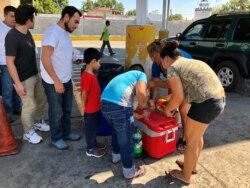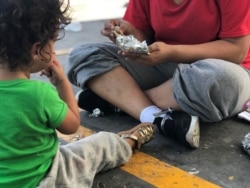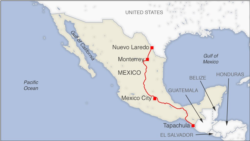VOA Immigration Reporter Aline Barros contributed to this report from Washington.
NUEVO LAREDO, MEXICO — Off to the side of the Puente #1, the bridge that connects pedestrians, drivers and cyclists from the Texas city of Laredo to the Mexican city of Nuevo Laredo, dozens of migrants and asylum-seekers sit on what was built as a parking lot for the customs office.
The concrete radiated after hours of 42-degree Celsius (108-degree Fahrenheit) heat from the sun.
They hadn't been able to shower in three days, several said. U.S. Customs and Border Protection (CBP) often apprehended them within an hour of crossing the river, held them for two to three days, then transported them back to Mexico.
Now a month after the start of the Trump administration's Migration Protection Protocols (MPP) in Nuevo Laredo, the Mexican government is busing hundreds of returned migrants to faraway Chiapas, in what is described as a thinly disguised deportation program.
Bus departures
VOA witnessed two nights of bus departures from a location adjacent to a pedestrian bridge where CBP dropped off migrants to await their immigration hearings in the U.S. from outside the country.
The first, around 12:30 a.m. on August 7, consisted of eight full buses, transporting 350 to 400 migrants; the next night, another three buses departed from the same location, carrying approximately 120 people, largely families with children under age 10.
The majority of migrants VOA spoke with ahead of their 2,100-kilometer (1,300-mile) journey were from Honduras and had crossed the Rio Grande into the United States in the first days of August.
Some of the migrants who spoke to VOA said they felt their hearings stood no chance and would self-deport to their respective countries. Others planned to utilize temporary work permits in southern Mexico while they considered their next moves.
MPP, also known as the "Remain in Mexico" policy, began in January 2019 in other border cities. It expanded in earnest in March, and then June, as Mexico scrambled to respond to the U.S. threat of tariffs if the number of unauthorized border crossings did not decrease.
In a statement to VOA, a CBP spokesperson said MPP allows the U.S. "to more effectively assist legitimate asylum-seekers and individuals fleeing persecution while migrants with false or meritless claims no longer have that incentive to make the journey."
The Trump administration said it created the program to alleviate overcrowding in U.S. detention facilities by making migrants await immigration court dates in Mexico.
The United States has returned more than 30,000 migrants to Mexico under the policy, CBP acting Commissioner Mark Morgan said Thursday.
According to an analysis by Human Rights First, CBP has returned an average of 450 migrants per day to Mexico in early August, more than double the rate of returns in early June.
More than 3,000 migrants have been returned to Nuevo Laredo during MPP's first month operating in the city, the independent, U.S.-based human rights organization reported.
That number includes children and adults who have been apprehended crossing the Rio Grande without authorization by U.S. Border Patrol agents, as well as people who presented themselves at ports of entry to formally request asylum.
Left in border city
The migrants VOA met hours after their return from the U.S. were predominantly from the Northern Triangle countries of El Salvador, Guatemala and Honduras. Many felt they had no real choice but to leave on the buses, wherever they were headed, just to get out of Nuevo Laredo.
Sitting in the shade of a bus shelter, they were trying to determine who wanted to go where, and how they would get there.
Few had cellphones or money to contact relatives. They had no knowledge of the city, no map and no means to get to a local shelter. All they carried were clear plastic bags with a few toiletries, paperwork, and the phone numbers of relatives to call when they could borrow a phone from someone with cell service in Mexico.
The Mexican city's reputation as a hub of drug cartel activity and ransom kidnappings kept many migrants within the confines of the parking lot adjacent to Puente #1.
The U.S. State Department posts a maximum "Level 4: Do Not Travel" warning because of crime and kidnapping in the surrounding state of Tamaulipas, where "armed criminal groups target public and private passenger buses as well as private automobiles," according to its advisory.
"They bring us here, where you're surrounded by the Zetas drug cartel, and in the end, what security do we have?" said Yuna, a Cuban asylum-seeker returned under MPP, who boarded one of Tuesday's eight buses to Tapachula, Chiapas. "We can't [take a taxi] because they'll send us to the lion's mouth. If we go to the [bus] station, they'll kidnap us."
But according to Nuevo Laredo Mayor Enrique Rivas Cuellar, "The issue of insecurity is not exclusive to the border."
"Everywhere, there are risks, there are dangers in a city you don't know," Rivas Cuellar told VOA.
Awaiting US court hearings
Although Mexican immigration authorities first thinned the number of returnees in Nuevo Laredo by busing some to Monterrey, roughly 220 kilometers (137 miles) to the southwest, this week the buses were bound for Tapachula, Chiapas, roughly 10 times farther away.
Monterrey is at a Level 3 warning, with the caution to "reconsider travel due to crime" and curfews on U.S. personnel in the area.
Chiapas, the more recent destination, is considered a Level 2 safety risk, according to the State Department, which urges visitors to "exercise increased caution due to crime."
It is also Mexico's southernmost state, which means that within the country's boundaries, it gets as close to Guatemala — and in turn, El Salvador and Honduras — as a person possibly could be while remaining in Mexico.
That distance puts 35 hours of road travel between the migrants and their court dates in border cities, some for September, others as late as November, requiring additional expenses few people VOA spoke with could afford. A one-way return economy bus ticket, with a connection in Mexico City, costs $111.
Mexico's National Institute of Migration did not respond to an emailed request for more information about the busing system.
The first buses bound for Chiapas left on August 2, according to one local media report.
Father Julio López, the head of the Nazareth migrant shelter in Nuevo Laredo, said that southbound trip — while in theory is voluntary but in practice feels like the only option to some migrants — shows that from the outset, even the name of policy was a ruse.
"The Migrant Protection Protocol is, to me, a protocol of lies for migrants," the priest said. "There is no protocol, and if there were one, it's not for protection. There is no protection."
Likewise, a Mexican federal immigration agent at the CBP drop-off site near the bridge said he believed MPP was not a policy of waiting for court dates, but rather one of "dolled-up deportations."
"Honestly, what we're seeing here, these are deportations," he told VOA. "Deportations in disguise."
CBP deferred comment to the U.S. Department of Homeland Security (DHS) in response to a VOA inquiry about whether the MPP program effectively works as a deportation plan. DHS and Mexico's National Institute of Migration have not yet responded to similar inquiries.










